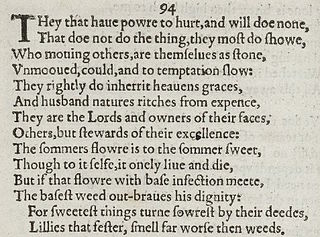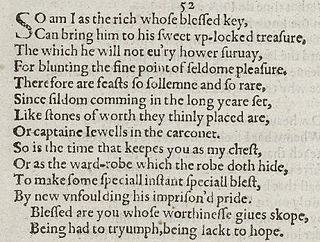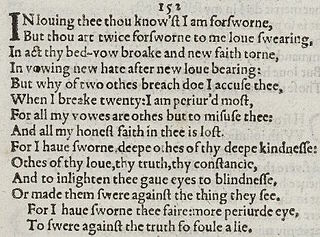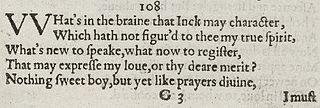| Sonnet 142 | |||||||
|---|---|---|---|---|---|---|---|
 Sonnet 142 in the 1609 Quarto | |||||||
| | |||||||
| |||||||
Sonnet 142 is one of 154 sonnets written by the English playwright and poet William Shakespeare.
| Sonnet 142 | |||||||
|---|---|---|---|---|---|---|---|
 Sonnet 142 in the 1609 Quarto | |||||||
| | |||||||
| |||||||
Sonnet 142 is one of 154 sonnets written by the English playwright and poet William Shakespeare.
Sonnet 142 is an English or Shakespearean sonnet. The English sonnet has three quatrains, followed by a final rhyming couplet. It follows the typical rhyme scheme of the form ABAB CDCD EFEF GG and is composed in iambic pentameter, a type of poetic metre based on five pairs of metrically weak/strong syllabic positions. The 14th line exemplifies a regular iambic pentameter:
× / × / × / × / × / By self-example mayst thou be denied! (142.14)
The 2nd line contains three common metrical variants: an initial reversal, a mid-line reversal, and a final extrametrical syllable or feminine ending:
/ × × / / × × / × /(×) Hate of my sin, grounded on sinful loving: (142.2)
Line 4 necessarily shares a feminine ending. An initial reversal can also be found in line 1, and potentially in lines 3, 5, 8, and 12; another mid-line reversal can be found in line 5.
The meter demands two variant (and unusual to modern ears) pronunciations: line 8's "revenues" is stressed on the second syllable, and line 9's "Be it" functions as one syllable. [2]
While frequently the rhythm of iambic pentameter lines arises from the implicit emphasis of its words, this sonnet affords several examples of the implicit emphasis of words arising from the meter. For example, in line 9, Shakespeare diverts the ictus away from the two strong tonic stresses of "love" and "lov'st" by arranging the line such that the meter implies contrastive accent on the four pronouns surrounding them:
× / × / × / × / × / Be it lawful I love thee, as thou lov'st those (142.9)

Sonnet 94 is one of 154 sonnets written by the English playwright and poet William Shakespeare. It is a member of the Fair Youth sequence, in which the poet expresses his love towards a young man.

Sonnet 10 is one of 154 sonnets written by the English playwright and poet William Shakespeare. It is a procreation sonnet within the Fair Youth sequence.

Sonnet 52 is one of 154 sonnets written by the English playwright and poet William Shakespeare. It is a member of the Fair Youth sequence, in which the poet expresses his love towards a young man.

Sonnet 61 is one of 154 sonnets written by the English playwright and poet William Shakespeare. It is a member of the Fair Youth sequence, in which the poet expresses his love towards a young man.

Sonnet 91 is one of 154 sonnets written by the English playwright and poet William Shakespeare. It's a member of the Fair Youth sequence, in which the poet expresses his love towards a young man.

Sonnet 152 is a sonnet by William Shakespeare. It is one of a collection of 154 sonnets, dealing with themes such as the passage of time, love, beauty and mortality, first published in a 1609.

Sonnet 150 is one of 154 sonnets written by the English playwright and poet William Shakespeare. It is considered a Dark Lady sonnet, as are all from 127 to 152. Nonetheless 150 is an outlier, and in some ways appears to belong more to the Fair Youth.
Sonnet 149 is one of 154 sonnets written by the English playwright and poet William Shakespeare.

Sonnet 143 is one of 154 sonnets written by the English playwright and poet William Shakespeare.
Sonnet 137 is one of 154 sonnets written by the English playwright and poet William Shakespeare.

Sonnet 75 is one of 154 sonnets written by the English playwright and poet William Shakespeare. It is a member of the Fair Youth sequence, in which the poet expresses his love towards a young man.

Sonnet 119 is one of 154 sonnets written by the English playwright and poet William Shakespeare. It's a member of the Fair Youth sequence, in which the poet expresses his love towards a young man.

Sonnet 90 is one of 154 sonnets written by the English playwright and poet William Shakespeare. It is a member of the Fair Youth sequence, in which the poet expresses his love towards a young man.

Sonnet 108 is one of 154 sonnets written by the English playwright and poet William Shakespeare. It is a member of the Fair Youth sequence, in which the poet expresses his love towards a young man.

Sonnet 111 is one of 154 sonnets written by the English playwright and poet William Shakespeare. It is a member of the Fair Youth sequence, in which the poet expresses his love towards a young man.

Sonnet 114 is one of 154 sonnets written by the English playwright and poet William Shakespeare. It is a member of the Fair Youth sequence, in which the poet expresses his love towards a young man.

Sonnet 115 is one of 154 sonnets written by the English playwright and poet William Shakespeare. It is a member of the Fair Youth sequence, in which the poet expresses his love towards a young man.
Sonnet 120 is one of 154 sonnets written by the English playwright and poet William Shakespeare. It's a member of the Fair Youth sequence, in which the poet expresses his love towards a young man.

Shakespeare's sonnet 117 was first published in 1609. It uses similar imagery to Sonnet 116 and expands on the challenge in the closing couplet. Using legally resonant metaphors, the poet defends himself against accusations of ingratitude and infidelity by saying that he was merely testing the constancy of those same things in his friend.

Sonnet 121 is one of 154 sonnets written by the English playwright and poet William Shakespeare. It is a member of the Fair Youth sequence, in which the poet expresses his love towards his young lover.